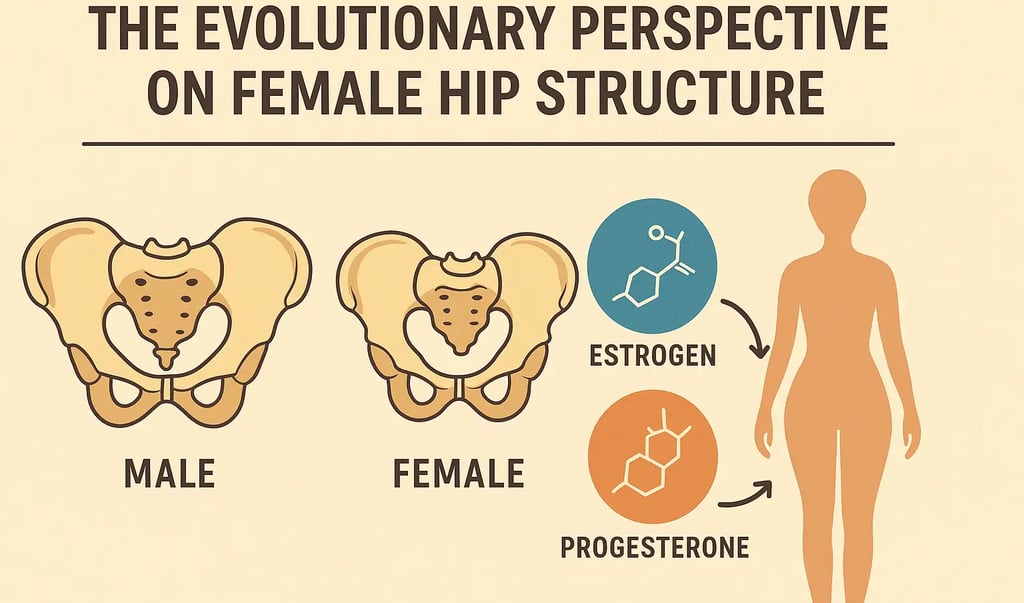The Evolutionary Perspective on Female Hip Structure: Anatomy, Hormones, and Cultural Significance
Discover the evolutionary role of female hip structure, from anatomical differences and hormonal influence to cultural significance. Learn how women’s hips impact childbirth, reproduction, and body image.


The Evolutionary Perspective on Female Hip Structure
The structure of the female hip has played a vital role in human evolution, particularly in relation to childbirth and reproductive success. Unlike the male pelvis, the female pelvis is wider and more circular, a characteristic that evolved to accommodate childbirth. This adaptation provided women with a larger birth canal, increasing the chances of safely delivering infants.
From an evolutionary standpoint, these changes were driven by natural selection, where women with wider hips had higher reproductive success. Over time, this led to a more distinct pelvic shape in females, balancing both bipedal locomotion and the demands of reproduction.
Anatomical Differences: Male vs. Female Hips
The human hip structure varies significantly between sexes:
Female pelvis: Broader, more circular, and with a larger subpubic angle.
Male pelvis: Narrower, heart-shaped, and with a sharper pelvic angle.
These differences are primarily linked to the evolutionary adaptation for childbirth. The wider female hips provide additional space for pregnancy and delivery while also influencing gait, balance, and movement mechanics.
Interestingly, these anatomical traits extend beyond biology. Cultural perceptions of body image often highlight female hips as symbols of femininity, beauty, and fertility.
Hormonal Influence on Hip Development
Hormones play a crucial role in shaping the female hip structure throughout life stages:
Puberty: Estrogen increases, widening the pelvis and creating the classic hourglass figure.
Pregnancy: Elevated estrogen and progesterone levels contribute to pelvic expansion and fat storage around the hips and thighs, ensuring energy reserves for fetal development.
Menstrual cycle: Fluctuating hormones may cause temporary changes in hip fat distribution and water retention.
Menopause: A decline in estrogen often leads to reduced bone density and changes in hip fat storage.
These hormonal shifts explain why hip structure and fat distribution change over a woman’s lifetime, influencing both appearance and reproductive capacity.
Cultural and Societal Significance of Women’s Hips
Women’s hips carry deep cultural, social, and symbolic meanings across societies:
Fertility and beauty: In many African and Indigenous cultures, wider hips are celebrated as indicators of fertility and strength.
Western ideals: Beauty standards have shifted over time, from preferring slender bodies to curvier figures, often influenced by media and fashion trends.
Body image: Modern advertising frequently imposes narrow beauty ideals, affecting women’s self-perception. However, the rise of body positivity movements challenges these stereotypes, promoting acceptance of all body types.
Historically, women’s hips have been celebrated in art, literature, and cultural symbolism, often associated with femininity, sexuality, and motherhood. Recognizing these perspectives helps create a more inclusive understanding of beauty and body diversity.
Conclusion
The female hip structure is not just a matter of anatomy—it reflects a remarkable evolutionary adaptation, hormonal influence, and cultural symbolism. From facilitating childbirth to shaping societal views of beauty, women’s hips highlight the intersection of biology, reproduction, and culture.
By appreciating both the scientific and cultural significance of hips, we gain a deeper understanding of how female anatomy has shaped human history, identity, and self-perception.
